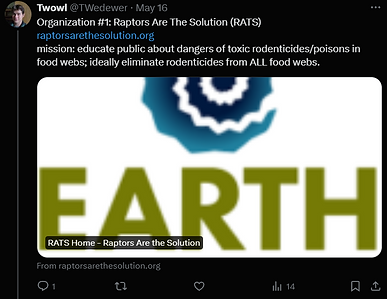Media Showcase
Welcome to my Social Media Campaign to reduce rodenticide pest control.

Here I detail my journey of using Twitter (X) as both a research/learning tool and as an advocacy platform.
In my writing, I prefer to say more with less words; Twitter was the perfect opportunity to hone this skill through writing short but sweet captions, summaries, and threads containing the most important parts of my research.
My online efforts have advanced my knowledge of social media advocacy and (hopefully) advanced the online presence of the owl conservation cause.
<-Social Media Campaign->
Day-by-Day Walkthrough
Class Objectives for using Twitter (X)
-
To serve as a research tool used to learn about topics/researchers/problems/solutions/organizations
-
To practice online/internet researching: using hashtags, keywords, following authors, etc.
-
To practice writing multimedia text (images/video and text)
-
To practice creating visual communication (infographics)
-
To practice writing concisely
-
To practice persuasion, gaining reader engagement
-
To create conversation between classmates
-
To learn how to use social media for effective scicomm
-
To practice maintaining a professional online persona for academic purposes
-
To learn how social media can be an effective tool for animal advocacy
Social Media Campaign Project
Through this project, I learned how to use Twitter as a research tool and advocacy platform. I chose to advocate for owls, specifically to advocate for a reduction in chemical rodent control (rodenticide) as a means for reducing the amount of owls that suffer from secondary poisoning.
Twitter is an excellent network of people with a wide variety of interests. This network makes it easy to unify under common interests. My journey through Twitter has taught me a lot about making interesting outreach materials, as most of my tweets were made with the class in mind, not the visuals, hence their low outreach. In retrospect, I learned more about what doesn't work when making Twitter posts than what does. Regardless, this platform allowed me to easily advocate for a world that indirectly harms owls less.
PROBLEM TWEETS
Here are my most successful tweets about the problem of anticoagulant rodenticide secondary poisoning in owls.

I chose this post because it highlights the significant drawback of chemically controlling animal populations: some animals become genetically resistant or devise loopholes.
I'd be surprised if rodents could devise a loophole around an owl.

I chose this post because it received the 2nd most views of my problem posts, and because it had a lot of details below it.
TWEETS ABOUT ORGANIZATIONS
Here are my most successful tweets about organizations devoted to protecting owls from secondary anticoagulant rodenticide poisoning.

I chose this organization because they cover a broader range of animal species affected by rat poison.

I chose this organization because their mission directly aligns with my advocacy project's goal.
TWEETS ABOUT SOLUTIONS
Here are my most successful tweets about ways we can minimize chemical harm to owls.


Why use rat poison when mechanical control has always worked? Compared to SGAR poisoning, the rat will suffer less.
Owl boxes are easy to construct, therefore most people can install them and make a difference.
INFOGRAPHIC




